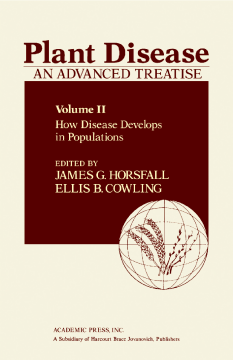
Additional Information
Book Details
Abstract
Plant Disease An Advanced Treatise, Volume II: How Disease Develops in Populations deals with the epidemiological aspect of disease in population of plants. Comprised of 18 chapters, this volume discusses the comparative anatomy, methods of research, instrumentation, computer simulation, and genetic basis of epidemics.
After briefly discussing the sociology of plant pathology, the book presents the comparative anatomy of epidemics in terms of their structure, patterns of development, and dynamics. This volume describes the rational processes of epidemiological research and how they differ from the processes used to investigate disease in individual plants. A chapter examines the instrumentation for measuring the weather component, including temperature, humidity, air movement, and irradiance. Other chapters discuss the measurement of disease on whole living plants; the theory and measurement of inoculum potential; the dispersal of pathogens in both time and space; and the movement and maintenance of infectivity by pathogens that operate below ground. This volume also deals with computer simulators of plant disease and the use of predictive models to forecast epidemics for management decision making. It describes some general patterns of changes in plant-part susceptibility with time for various groups of diseases caused by fungi or viruses. A discussion on the problems of genetic uniformity and susceptibility and the breeding and deployment strategies needed to cope with these problems is included. Other chapters examine the influence of climate and weather on epidemics; the analysis of the geographical and climatic distribution of plants in various parts of the world; and the hazardous practices that have favored epidemics. Lastly, the probabilities of success for quarantines against diseases of various types are provided.
This volume is an invaluable source for plant epidemiologists and pathologists, botanists, and researchers.
